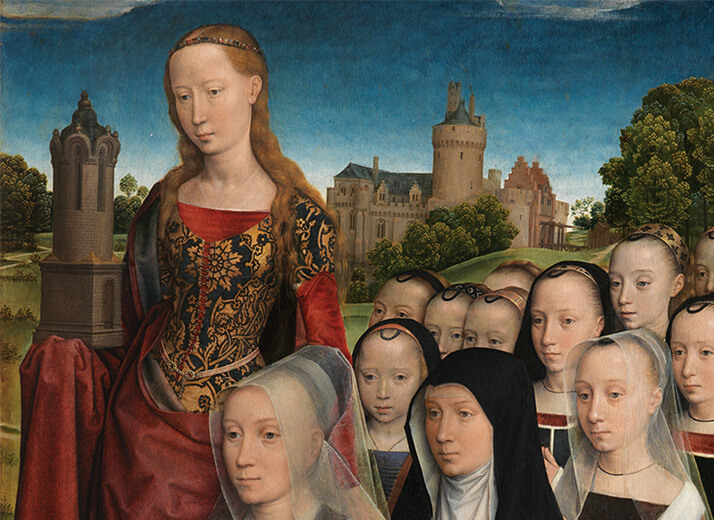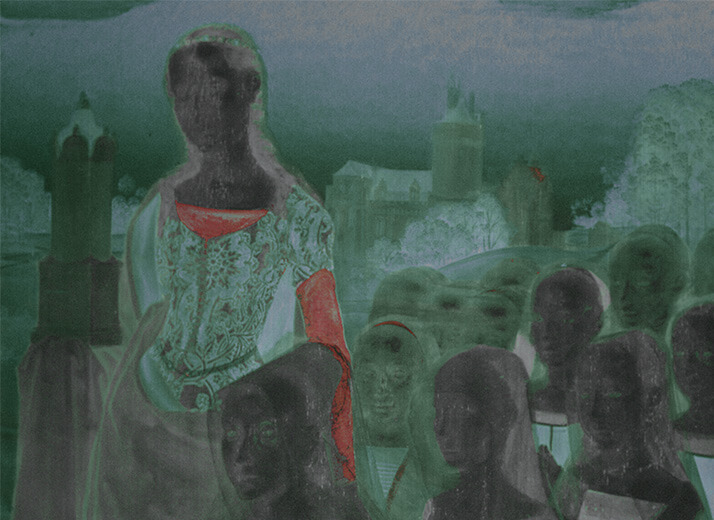“I combine my scientific activities with my fascination for how people lived and behaved in the past, and for the materials and technologies that influenced their lives,” says Koen Janssens, Professor of Chemistry at the University of Antwerp, Belgium. In the last decade he focused on historical glass, extracting information on production technologies and trade in the Antique and (post) Medieval period. He used quantitative major to trace-level micro analysis, using minute chips of glass sampled from archaeological finds as starting material. “My expertise is X-ray analysis, and since X-rays are non-destructive and non-invasive, it was natural to start developing instrumentation to look ‘inside’ oil paintings and related works of art,” he says. To do so, Janssens has worked alongside Joris Dik of Delft University of Technology. “It is mainly through Joris’s extensive network of connections in museums worldwide that we have been able to demonstrate, refine and use our new XRF-based imaging method on well-known works of art.”

Koen Janssens is professor of Analytical Chemistry at the University of Antwerp, Belgium. Geert Van der Snickt and Matthias Alfeld are researchers in his group. Anne Van Oosterwijk is scientific collaborator and Till-Holger Borchert is chief curator of the Groeninge museum, Bruges and Hohenberg Chair of Excellence in Art History at University of Memphis, US. Joris Dik is Antoni van Leeuwenhoek professor at Delft University of Technology, Netherlands.
Did the Moreel triptych initially look like it does today? If not, what was changed? And what does it tell us about the creative process that led to this masterpiece of medieval art?
This altarpiece was painted for the Moreel family. William Moreel, Seigneur of Oost Cleyhem, was one of the wealthiest and most politically active men in Bruges. He was married to Barbara van Vlaederberghe van Hertvelde and they had eighteen children. They ordered this altarpiece for their funerary chapel in the Church of St. Jacques in Bruges, founded in 1484. The lower frame of the wings and the center panel bear the same date. On the interior wings, the parents are represented with 16 of their children. On the left, William Moreel is shown with his five sons behind him and flanked by his name patron saint, William of Aquitaine. On the right panel, Mrs Moreel and her daughters kneel next to St. Barbara. Of the eleven daughters depicted, the oldest wears the habit of a Dominican nun. X-ray radiographs of the side panels, recorded several decades ago, suggested that changes were made to the representation and position of the minor characters in both wings. The objective was to visualize more clearly any pentimenti to better understand the evolution of the triptych.
To see through the upper layers of paint to lower layers that are now visible and offer information about the original painting.
X-ray fluorescence is a non-destructive method of element analysis. Materials are irradiated with high energetic radiation ionizing atoms which, upon relaxation, emit X-radiation that is different for each atom. Using suitable solid state detectors, signals can be recorded for many chemical elements. A motorized assembly moves an X-ray tube and detectors in small steps over the surface of a painting, determining the local composition and generating element-specific distribution images of the painting.


Radiation from fairly deep below the surface can be detected, revealing overpainted representations that are no longer visible to the naked eye. Most pigments are characterized by one or more characteristic chemical elements; many traditional pigments, such as malachite green and verdigris contain copper, vermillion red contains mercury, umber contains manganese and iron, etc. Combining elemental maps allows the construction of a (false) colour 'photo' of a buried paint layer.
Copper distribution (see figure, right) reveals that in the original version of the right panel only four daughters were depicted against a landscaped background, painted with one or more Cu-containing green pigments. Much more of the hill/lawn to the right of Mrs Moreel was originally visible; in the landscape, positions were left open for her portraits and four daughters. The faces of the additional seven daughters were painted later on top of the verdant background. The mercury map (red) reveals that Mrs Moreels’ hat was originally less elongated. A different red (not containing mercury) was used to paint St. Barbara's skirt than the red parts of her left arm and bodice. Possibly the vermillion in these areas was added in a later restoration phase. Finally, the scatter intensity image (grey/white in the figure) suggests that Mrs Moreels and her oldest daughter (now wearing a nun's habit) originally wore more revealing dresses, as is still the case for the second daughter (to the right of the nun). Also in left panel of the triptych (not shown), changes were made to the positions of the male children behind William Moreel and the portrait of his fourth son inserted. From this we can conclude that the process of creating this altarpiece went through at least two major stages. The relatively young Moreel family was represented in a balanced manner against a green landscape. In the second phase, incorporating the younger children, some of the balance of the representation was sacrificed by the artist. This also allowed a number of minor aspects of the painting (such as the dress of the eldest daughter) to be brought up-to-date. This shows how MA-XRF allows art-historians and conservators to explore in greater depth and with unprecedented detail the creative process that led to paintings of this type.
Koen Janssens is professor of Analytical Chemistry at the University of Antwerp, Belgium. Geert Van der Snickt and Matthias Alfeld are researchers in his group. Anne Van Oosterwijk is scientific collaborator and Till-Holger Borchert is chief curator of the Groeninge museum, Bruges and Hohenberg Chair of Excellence in Art History at University of Memphis, US. Joris Dik is Antoni van Leeuwenhoek professor at Delft University of Technology, Netherlands.
Please read the other articles in this series:
Casting Light on Renaissance Illuminations
The Stories That Colours Tell
Understanding Ancient Prescriptions




